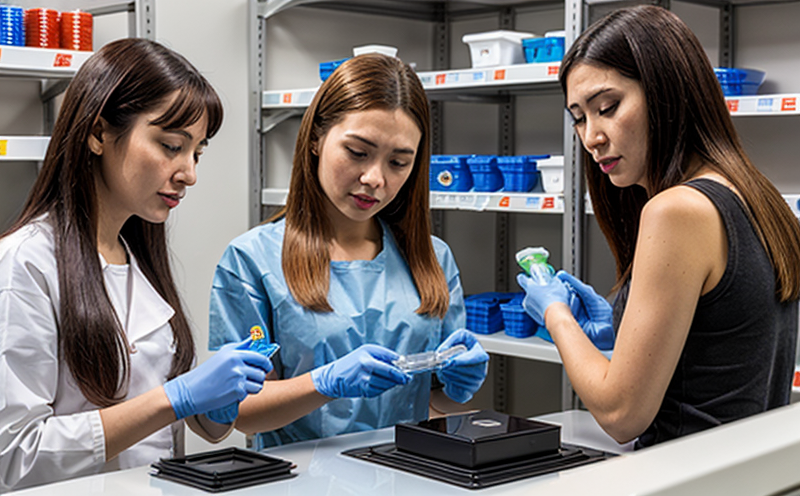ASTM D6866 Radiocarbon Content Testing of Consumer Plastics
The ASTM D6866 standard provides a method to determine the radiocarbon content in plastic materials, which is crucial for identifying their origin and age. This test helps in distinguishing between fossil-based plastics (petroleum-derived) and bioplastics derived from renewable resources like cornstarch or plant cellulose.
Understanding this parameter is essential for various sectors such as consumer goods, pharmaceuticals, and electronics, where the environmental impact of packaging materials directly affects brand reputation. The radiocarbon test offers a non-destructive way to differentiate these types of plastics, aiding in sustainability initiatives and compliance with regulatory requirements.
The process involves measuring the radiocarbon content using Accelerator Mass Spectrometry (AMS) or conventional mass spectrometric techniques. This method is particularly effective for identifying bioplastics that are less than 50 years old, as they contain a higher percentage of modern carbon compared to fossil-based plastics.
In consumer goods manufacturing, the ASTM D6866 test can help in ensuring product authenticity and sustainability claims. For instance, companies committed to reducing their carbon footprint may use this information to source bioplastics for eco-friendly packaging. This not only enhances brand image but also aligns with global trends towards sustainable practices.
From an R&D perspective, the radiocarbon content test is invaluable for developing new materials and improving existing ones. By understanding the carbon composition of different plastic types, researchers can innovate more environmentally friendly products. Additionally, this information aids in optimizing production processes to minimize waste and resource consumption.
The ASTM D6866 method also plays a key role in quality control and assurance within manufacturing plants. It helps monitor the consistency of raw material inputs, ensuring that the final product meets specified standards for carbon content. This is particularly important for brands that emphasize sustainability and need to maintain consistent performance across their product lines.
In summary, ASTM D6866 radiocarbon content testing offers a robust solution for identifying the origin and age of plastic materials used in consumer goods. By leveraging this technology, companies can enhance their environmental responsibility, improve product quality, and ensure compliance with regulatory standards. This service is indispensable for any organization aiming to incorporate sustainable practices into its operations.
Why Choose This Test
The ASTM D6866 radiocarbon content test offers several advantages that make it an essential tool in consumer plastics testing:
- Accurate Identification of Plastic Origin: The test provides precise information about the origin of plastic materials, distinguishing between fossil-based and bioplastics.
- Non-Destructive Testing: Unlike some other tests that require destructive sampling, ASTM D6866 allows for non-destructive analysis, preserving the integrity of the sample.
- Regulatory Compliance: Many industries are subject to strict regulations regarding the use and origin of materials. This test ensures compliance with international standards such as ISO 14021 and EN 15378.
- Sustainability Focus: By identifying bioplastics, companies can enhance their sustainability credentials, appeal to eco-conscious consumers, and contribute positively to environmental initiatives.
- Innovation Support: R&D teams benefit from this test by gaining insights into the composition of different plastic types, which aids in material selection and product development.
- Quality Assurance: Consistency in raw materials is crucial for maintaining quality standards. The ASTM D6866 test helps achieve this by providing reliable data on carbon content.
These benefits underscore why the ASTM D6866 radiocarbon content test stands out as a critical service for consumer goods manufacturers and other related sectors.
Customer Impact and Satisfaction
The ASTM D6866 radiocarbon content test significantly impacts customers by providing valuable insights into the materials used in their products. This information is crucial for several reasons:
Enhanced Product Authenticity: By ensuring that bioplastics are accurately identified, companies can maintain product authenticity and prevent any discrepancies that could lead to consumer distrust.
Informed Decision-Making: Customers can make informed choices about the environmental impact of their products. This transparency fosters trust and loyalty among consumers who value sustainability.
Regulatory Compliance: The test helps customers stay compliant with international standards, avoiding potential legal issues and fines associated with non-compliance.
Innovation and Development: By providing data on material composition, the test supports continuous improvement in product design and development. This ensures that products remain at the forefront of technological advancements.
Sustained Performance: Consistent raw materials lead to consistent product performance. The ASTM D6866 test ensures this consistency, enhancing customer satisfaction with reliable and high-quality products.
In summary, the ASTM D6866 radiocarbon content test has a profound impact on customers by ensuring authenticity, compliance, sustainability, innovation, and sustained performance in their products.
Competitive Advantage and Market Impact
- Brand Differentiation: Companies that use ASTM D6866 to identify bioplastics can differentiate themselves from competitors by offering more eco-friendly products, thereby attracting environmentally conscious consumers.
- Regulatory Leadership: By ensuring compliance with international standards and regulations, companies demonstrate their commitment to sustainability, positioning them as leaders in the industry.
- Innovation Leadership: The test supports R&D efforts by providing insights into material composition, enabling companies to innovate more effectively and stay ahead of market trends.
- Sustained Performance: Consistent raw materials lead to consistent product performance. Companies that use the ASTM D6866 test can ensure this consistency, gaining a competitive edge in terms of reliability and quality.
- Eco-Friendly Image: By identifying bioplastics, companies can enhance their environmental image, which is increasingly important for consumer perception.
- Cost Efficiency: Long-term use of ASTM D6866 ensures that companies are using the most sustainable and cost-effective materials, reducing operational costs in the long run.
The ASTM D6866 radiocarbon content test thus provides a strong foundation for competitive advantage and market impact. By leveraging this service, companies can enhance their reputation, stay ahead of competitors, and ensure long-term success in the marketplace.





